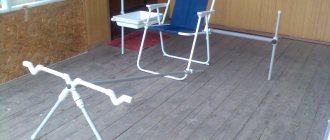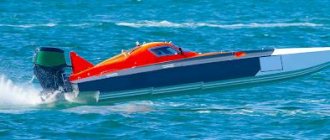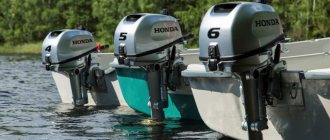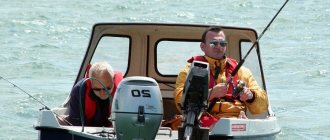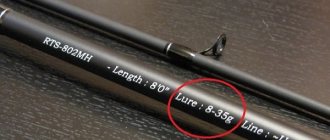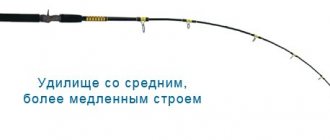What valves are used on inflatable boats
There are a wide variety of valves that can be installed on PVC boats. Some of the best are:
- Air valves. The mechanism of operation of such a valve is quite simple. When closed, it does not allow air to pass through due to a certain position of the pin, which is located in the middle of the valve. When you press the pin, the valve begins to let air through and the boat lowers. Such valves are most often installed on boats of domestic and foreign production.
- Reed valves. This type of valve has the form of a plate and special petals, which bend in the desired direction under air pressure. So, when the boat is filled with air, the valve petals move down, and when lowered, they bend upward. This type of valve can be found on some domestically produced boats, as well as foreign ones, for example, French boats.
- Rubber valves. Used by many manufacturers of inexpensive PVC boats. Sometimes such dampers or valves are called elastic. One of the main advantages of such dampers is that they are inexpensive and can be easily replaced if necessary. It is worth noting that such mechanisms also have disadvantages. Firstly, they wear out quickly, and secondly, when small grains of sand get inside the mechanism, partial deflation of air from the boat occurs. Of course, you can buy such valves, but if used for a long time, they will not last you long.
The purpose of all these valves is to ensure that the PVC boat is filled with air. Any minor damage to the valve may cause air to gradually escape from the boat, which may result in a change in the performance of the boat.
What valves are there in the boat?
There are only two types of valves in a PVC boat:
- Air - maintain stable pressure in the boat's cylinders and prevent air from escaping outside. Air ones also include bleed or safety ones - they release air when there is excess pressure, this is necessary so as not to worry that your boat will burst in the heat or from overinflated cylinders.
- Drains are necessary to drain water that, one way or another, gets inside the boat. Even if you drive the boat very carefully, there will still be water in the cockpit. They help get rid of water without connecting a pump.
Air valve
Although there is a wide variety of PVC boats in the world, there are not many options for valve designs. Many people have heard the names of such valves as Ceredi, Boston, Golubev valve, Bravo, Telerad.
In the process of evolution, the simplest design mechanisms were replaced by more advanced ones.
Design No. 1
The simplest design consists of a polyethylene base, a cork and a rubber gasket that connects the cork and the base; they are used on older models of Russian rubber boats.
Design No. 2
This is one of the simplest designs, which is most often installed on recreational boats; the likelihood of breakage is low. Such valves are found in some rubber boats.
Advantages: you can quickly deflate or inflate air into the boat’s cylinder.
The disadvantage is the need for a special pump with a locking mechanism. In addition, you should inflate the cylinder slightly more than necessary, since the valve will release air until the cap is screwed in.
This principle is known to many, since the wheels of Soviet bicycles had a similar design.
This type of valve consists of:
- a flange glued into the cylinder (valve cup);
- screw-in locking plug with rubberized gasket.
Design No. 3
This model is the most modern, equipped with a Push-push (push-push) system; when pressed for the first time, the structure moves away from the walls, allowing air to pass through, and when pressed again, it closes and locks the valve.
In such a valve, a glass and a counter part are distinguished. The glass is placed inside the boat cylinder, into which the mating part is screwed, it closes or opens the valve.
Advantages - You can inflate the boat just as much as needed without worrying about it deflating while you close the plug.
The disadvantage is that it fails when debris and dirt get into the valve petals, but it can be cleaned and then the valve will not leak air.
We can say that this is a diaphragm valve, it consists of:
- valve body;
- membranes;
- plugs with lock.
This design is used on almost all modern boats.
Drain valve
The drain valve is also called the drain valve. As a rule, it is installed at the bottom of the transom. You can bleed water both on the shore and while the boat is moving. Not all boat models have it.
Which valve is better to choose?
Air valves are among the most durable and reliable. They do not allow air and water to pass through, are quite inexpensive, and if it is necessary to replace or repair the valve, such work can be carried out independently.
Reed and flexible valves are more likely to wear out and break. One of the main advantages of such valves is that they are flexible and are slightly cheaper than air mechanisms. As for the installation of reed or elastic valves, replacing them is quite simple.
You can choose any of the above types of valves, but the mechanism you purchase must be:
- Reliable. When purchasing a valve, pay attention to the material from which it is made, as well as its strength. Quality valves should be made of rubber, durable rubber, or PVC.
- Match quality and price . When choosing between an expensive and a cheaper product, choose the one that has the best quality. More expensive doesn't always mean better.
- Be resistant to various environments, such as acids, direct sunlight, high or low temperature, etc.
Variety of PVC boat valves
There are a considerable number of valve designs for inflatable boats, used depending on the specific need - from official ones to the developments of “folk craftsmen”, but the following types are most widespread, which are installed on the vast majority of swimming equipment:
In addition to the glass and the outer part, it is equipped with a central pressure pin on a spring, which is needed to automatically discharge excess air mixture. If the cylinders are pumped, then the internal pressure presses the moving part against the pin and part of the air is released. This will prevent the boat from exploding due to expansion of the gas mixture if the outside temperature is too high.
Bleeding valve.- Reed valves. They are round membranes divided into sectors, located inside the mating part. When inflated, the air pressure presses them out and opens the inlet. After which, under the influence of internal pressure, they are pressed upward, which prevents air from escaping. They are usually installed by owners of two-stroke engines on motor boats.
- Golubev valve. It is an average option that combines the advantages of the other two models. The closure is ensured by a membrane, and if it is necessary to bleed air, it is equipped with a push button. To improve the reliability of the mechanism, after closing it is additionally rotated, which completely protects the valve from accidental opening. Owners of Ufa rowing and motorized swimming equipment fully appreciated the advantages of this type of closing mechanism.
Each model has its own advantages and characteristics, which are the basis for determining which valve would be preferable to install on your inflatable boat.
How to check a valve for malfunction
In order to make sure that the valve is working properly or malfunctioning, it is necessary to check it for damage.
There are several ways to determine whether the valve is poisoning or not. It is worth noting that it is recommended to check whether the valve allows air to pass through each time before using a PVC boat. This must be done in order to protect yourself on the water.
Two ways to check the valve for leaks:
- Using a soap solution. This method is very simple. In order to check whether the valve is leaking air, you need to prepare a soap solution, which consists of water, soap and oil. The prepared mixture must be applied to the area where the valve is adjacent to the boat, as well as to the valve area itself. If air bubbles appear on the application surface, this means that the valve is actually leaking.
- For the second method you will not need anything other than a pump and water. It is necessary to not fully inflate the boat and plunge it into the water so that the place with the valve is completely immersed in it. If air bubbles begin to come out of the water, this means that the valve is leaking air.
How to identify a valve malfunction
Any valve will wear out or be damaged. When this is detected immediately or at an early stage, a simple replacement may be an option. But if you do not carry out a thorough inspection periodically, this will lead to additional problems. It is best to inspect the valve immediately before each use of the water product and immediately after.
Verification methods:
Soap solution. You need to make the product in advance, dissolve the soap and a little oil. Then pump up the boat and coat the valve inside and around the entire area with the solution. Next, lock the device and watch for bubbles. When this happens, the watercraft allows air to pass through. Immersion. Do not fully inflate the boat and place it under water. If there is damage, it will be immediately noticeable. The air will come out in the form of bubbles. Just 30 minutes spent can save money and prevent consequences.
Why is the valve leaking air?
There are many reasons why a boat valve may start leaking air. As a rule, malfunction of this mechanism occurs due to mechanical damage and, very rarely, jamming of the moving part of the valve. It should also be noted that the valve may become unusable after prolonged exposure to frost.
Most often, the valve begins to leak air due to various damages, for example, detachment of the place where the valve is attached to the boat, or the destruction of certain parts due to the influence of various factors on them (frost, moisture, mechanical stress).
How to replace a valve on a PVC boat yourself
In order to unscrew the old valve or tighten it, you must use a special wrench. If such a key is not available, you can make it yourself using a plastic pipe of the same diameter as the boat valve.
Stages of valve dismantling:
- The boat must be completely deflated.
- Feel the glass (base) of the valve and fix it in the palm of your hand.
- Place the key in the base of the valve and begin to slowly turn it clockwise.
It should be noted that the boat valve may leak air due to dirt and dust accumulated in it. In this case, there is no need to replace the valve; you just need to clean the valve and lubricate it with automotive lubricant.
Installing a new valve is quite easy, using the same key. The new valve must be screwed in tightly, but not tightly. This must be done because this valve may have to be removed again at some point, and also in order to simply not damage it.
After the new valve is installed in its place, it is recommended to check it for leaks.
How to change the air valve
If the valve still fails, you need to replace it. Maybe it is just clogged and it will be enough to wash it to remove sand and dirt. But in any case, you first need to remove the valve and unscrew it.
Key selection
The valve is removed using a special key. This key can be found on sale. It happens that the key is sold in a kit for repairing a boat in so-called repair kits. It is also possible to purchase a universal key, double-sided, in an online store for 150 - 170 rubles.
You can make the key yourself. A plastic (preferably metal) tube of the required diameter is selected, and the required number of teeth are cut on it using a jigsaw to hook and unscrew the valve. But, let me make a reservation right away, manufacturers can put some valves on glue; a self-made key should serve as a stop, and not flimsy plastic.
Extraction
It is easier to close the valve on an inflated cylinder. But many do it on a flat boat. Hook the valve with a key and turn it clockwise.
If the key is good, then unscrew almost any valve, you can also try tightening it with pliers.
If a glass breaks, there are three ways to get it out:
Heat the fabric with a hair dryer , it will become soft and then take out the glass, but here it is important not to overdo it, not to stretch the fabric of the balloon too much, and to be careful. PVC fabric may not return to normal after heating; heating and twisting must be done carefully.
Breaking a glass - this method will work, if it is already broken, you need to try to pull it out slowly, breaking it into pieces, in general, try to save the fabric. This will require a long amount of time and strength.
Cutting is what they do in service centers. Usually the incision is made next to the glass. The incision is sealed with a patch.
Inspection
It is imperative to inspect the unscrewed valve. Blowing it with compressed air is not necessarily enough; just wiping it with a dry and clean cloth. Many people lubricate the rubber with silicone, only in a very thin layer so that it does not get on other parts of the boat.
The system itself with the spring will need to be washed from dirt and sand in water and liquid soap.
Replacement
Only with the valve unscrewed should you go to the store - if the boat is an old model, the valve may not fit, since the thread will be slightly different. Choose a completely similar valve in the store.
Screw the washed old or purchased new valve back in using a wrench, without tightening it until it creaks, so as not to twist the thread.
When screwing in, they also use silicone; they lubricate the edge of the PVC fabric, previously cleaned, and the valve itself at the place of screwing.
Pump air into the cylinder and use water and shampoo to check the reliability of the valve. If the valve is leaking, you can tighten it a little.
What is a valve key and how to choose it
Today there are many varieties of such keys; it is recommended to buy them either immediately complete with the valve, or selecting them for a particular mechanism.
It is worth noting that such a key can be made independently from a metal or plastic pipe. To do this, you need to cut a small piece of pipe, make two holes in it on top, and insert a strong wire into them. Scars must be made in the lower part. With this key you can easily unscrew or insert the valve mechanism.
Notes!
- The pipe should be about 20-25 centimeters.
- The holes in the pipe where the wire is inserted serve as a mechanism that allows you to turn the key.
- Scars can be made using a grinder or a hacksaw. The shape of the scars does not matter, since their purpose is to simplify the rotation of the valve.
- The diameter of the pipe depends on the diameter of the valve. Before making such a key yourself, it is recommended to calculate the diameter of the valve.
How to unscrew the valve
To remove the valve from the inflatable boat, you will need a special key. The key differs depending on the valve model. If you don’t have a key, you can make one yourself from a plastic pipe suitable for the diameter of the valve. To do this, you need to cut teeth in the pipe with a jigsaw to engage with the valve baffles.
The valve is dismantled as follows:
- deflate the boat;
- feel the valve glass through the material of the boat, holding it in your hand;
- Place the key in the valve hole and turn it clockwise.
Due to prolonged use of the boat, the valve threads may become clogged with dirt, making it difficult to unscrew the valve. In such cases, it is recommended to clean and blow with compressed air the area where dirt has accumulated. After cleaning the valve, lubricate it with automotive spray lubricant for easy unscrewing.
It is strictly not recommended to dismantle using improvised means, as there is a high probability of damage to the boat.
Blitz tips
To prevent valve wear, it is recommended:
- Periodically check the tightness of your boat. It is best to do this before using it.
- Avoid mechanical damage to the valve. To do this, it is enough to provide good conditions for storing the boat.
- Before unfolding and inflating the boat, you must first make sure that there are no piercing or cutting objects on the plane where you are going to do this.
- It is necessary to close the valve after inflating the boat with the lid. This must be done to prevent debris, small grains of sand, etc. from getting into the valve.
- Before installing a new valve, the installation site must be degreased and also impregnated with sealing lubricant before and after installation.
- Inflate the boat using the safety valve.
- When replacing the valve, it is not recommended to use foreign objects (especially sharp ones), as they can damage the integrity of the boat.
- It is recommended to buy air valves, keys and other components only from branded stores or trusted suppliers in order to avoid counterfeits.
- Do not buy low quality valves and boat repair parts. Remember that your safety on the water depends on the condition of your boat.
- During the winter season, it is recommended to store the boat in a heated room, and also periodically check it for leaks and integrity.
If all these points are observed, your boat will serve you for a long time without requiring additional costs.
When might you need to repair a PVC boat?
A PVC boat is easy to damage. Often, fishing enthusiasts discover a cut in the bottom of the boat, burns or a tear in the seam of the cylinder, which occurs due to the boat overheating in the sun. Repair is necessary in cases where:
- the boat lowers;
- the valve on the boat begins to poison;
- lowers the keelson;
- the seams are coming apart;
- the bottom of the PVC boat was broken;
- air bubbles and cracks form on the pump, etc.
Whatever the problem, don't despair. A PVC boat can almost always be repaired with your own hands or in special service centers.
